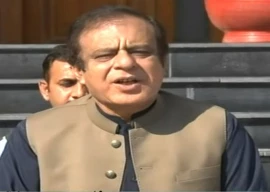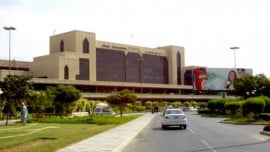
WASHINGTON: Archaeologists said Tuesday they have identified the remains of four men who were among the leaders of an early English settlement in Virginia's Jamestown.
It took years for scientists to identify the poorly preserved bones belonging to an Anglican priest and three military officials.
They were found in what is believed to be the oldest Protestant church in the modern-day United States.
The 1608 church was the location of tobacco grower John Rolfe's marriage to Pocahontas, a daughter of the local indigenous chief who was made famous by a Disney epic.
Humid and low-lying Jamestown is where Britain's world-changing empire began.
"It's a major discovery. These are the earliest English leaders to be discovered in America," Jamestown Rediscovery director Jim Horn told AFP.
 A Smithsonian Institution photo from July 28, 2015 shows the bones of four of the early leaders of Virginias's Jamestown settlement at an archeological dig in Jamestown, Virginia. PHOTO: AFP
A Smithsonian Institution photo from July 28, 2015 shows the bones of four of the early leaders of Virginias's Jamestown settlement at an archeological dig in Jamestown, Virginia. PHOTO: AFPAt a briefing, he told reporters: "After being lost to history for more than 400 years, their discovery reveals new clues about life, death and the importance of religion in one of England's most critical settlements."
The people whose remains were found ranged in age from 24-39. They were part of the imported elite at the ultimately ill-fated settlement south of Washington, the current US capital city.
And their lives coincided with a crucial time for the settlement which was near failure due to disease, hunger and war.
"With the discovery of four burials in the chancel of the church, we looked forward to the challenge of identifying these individuals by name," said Smithsonian forensic anthropologist Douglas Owsley.
 A skull from one of the early leaders of Virginias's Jamestown settlement is displayed at the Smithsonian Institute in Washington, DC on July 28, 2015. PHOTO: AFP
A skull from one of the early leaders of Virginias's Jamestown settlement is displayed at the Smithsonian Institute in Washington, DC on July 28, 2015. PHOTO: AFP"The skeletons of these men help fill in the stories of their lives and contribute to existing knowledge about the early years at Jamestown."
A combination of archaeology, skeletal analyses, chemical testing, 3-D technology and genealogical research combined to make identification a real possibility. In this case, it was success times four.
Only about 30 per cent of each skeleton had been recovered.
Reverend Robert Hunt, the colony's first Anglican priest, and Captain Gabriel Archer, were part of the first settlement campaign in 1607.
It was led by Captain John Smith, who was helped by Pocahontas.
Beside them were Sir Ferdinando Wainman, thought to be the first of England's elite to be buried in the Americas, and Captain William West.
West was killed in a battle with the local Powhatan indigenous tribe.
About a third of their remains had not decomposed, the scientists said, adding that their burial near the church choir indicated their high social status.
"Going to a colony in the new world for any European was a very risky business, very dangerous," Horn said.
"Starvation, Indian attacks and disease were the three major killers for these men. And this is not unusual that none of them would go beyond forty."
Archaeologists also said they had found a small silver box atop Archer's coffin.
CT scans of the sealed box revealed that it is likely a Catholic reliquary with pieces of bone and holy water inside.
Despite colonists' efforts to convert locals to Anglicanism, they said this discovery made it appear that at least one of the colonists kept his Catholic faith, perhaps secretly.


































1713509570-0/Taylor-Swift-Album-Release-(1)1713509570-0-270x192.webp)






















COMMENTS
Comments are moderated and generally will be posted if they are on-topic and not abusive.
For more information, please see our Comments FAQ